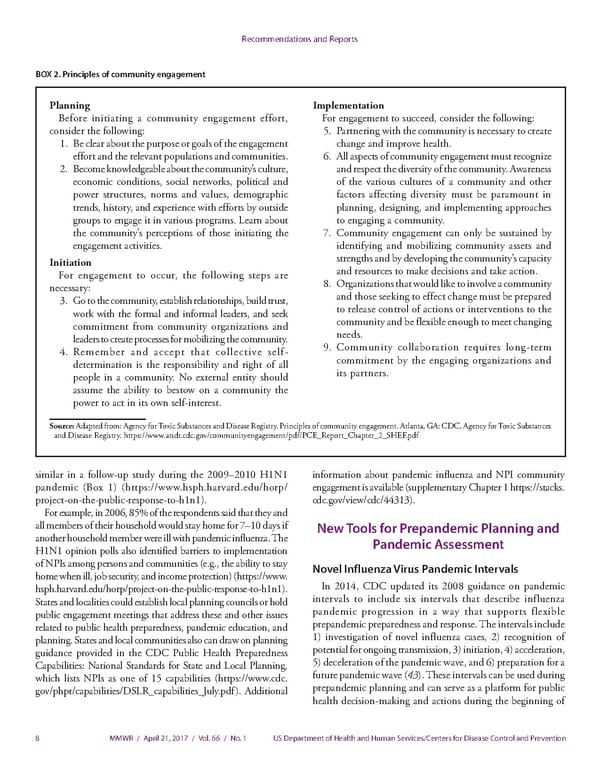Recommendations and Reports BOX 2. Principles of community engagement Planning Implementation Before initiating a community engagement effort, For engagement to succeed, consider the following: consider the following: 5. Partnering with the community is necessary to create 1. Be clear about the purpose or goals of the engagement change and improve health. effort and the relevant populations and communities. 6. All aspects of community engagement must recognize 2. Become knowledgeable about the community’s culture, and respect the diversity of the community. Awareness economic conditions, social networks, political and of the various cultures of a community and other power structures, norms and values, demographic factors affecting diversity must be paramount in trends, history, and experience with efforts by outside planning, designing, and implementing approaches groups to engage it in various programs. Learn about to engaging a community. the community’s perceptions of those initiating the 7. Community engagement can only be sustained by engagement activities. identifying and mobilizing community assets and Initiation strengths and by developing the community’s capacity For engagement to occur, the following steps are and resources to make decisions and take action. necessary: 8. Organizations that would like to involve a community 3. Go to the community, establish relationships, build trust, and those seeking to effect change must be prepared work with the formal and informal leaders, and seek to release control of actions or interventions to the commitment from community organizations and community and be flexible enough to meet changing leaders to create processes for mobilizing the community. needs. 4. Remember and accept that collective self- 9. Community collaboration requires long-term determination is the responsibility and right of all commitment by the engaging organizations and people in a community. No external entity should its partners. assume the ability to bestow on a community the power to act in its own self-interest. Source: Adapted from: Agency for Toxic Substances and Disease Registry. Principles of community engagement. Atlanta, GA: CDC, Agency for Toxic Substances and Disease Registry. https://www.atsdr.cdc.gov/communityengagement/pdf/PCE_Report_Chapter_2_SHEF.pdf similar in a follow-up study during the 2009–2010 H1N1 information about pandemic influenza and NPI community pandemic (Box 1) (https://www.hsph.harvard.edu/horp/ engagement is available (supplementary Chapter 1 https://stacks. project-on-the-public-response-to-h1n1). cdc.gov/view/cdc/44313). For example, in 2006, 85% of the respondents said that they and all members of their household would stay home for 7–10 days if New Tools for Prepandemic Planning and another household member were ill with pandemic influenza. The Pandemic Assessment H1N1 opinion polls also identified barriers to implementation of NPIs among persons and communities (e.g., the ability to stay Novel Influenza Virus Pandemic Intervals home when ill, job security, and income protection) (https://www. hsph.harvard.edu/horp/project-on-the-public-response-to-h1n1). In 2014, CDC updated its 2008 guidance on pandemic States and localities could establish local planning councils or hold intervals to include six intervals that describe influenza public engagement meetings that address these and other issues pandemic progression in a way that supports flexible related to public health preparedness, pandemic education, and prepandemic preparedness and response. The intervals include planning. States and local communities also can draw on planning 1) investigation of novel influenza cases, 2) recognition of guidance provided in the CDC Public Health Preparedness potential for ongoing transmission, 3) initiation, 4) acceleration, Capabilities: National Standards for State and Local Planning, 5) deceleration of the pandemic wave, and 6) preparation for a which lists NPIs as one of 15 capabilities (https://www.cdc. future pandemic wave (43). These intervals can be used during gov/phpr/capabilities/DSLR_capabilities_July.pdf). Additional prepandemic planning and can serve as a platform for public health decision-making and actions during the beginning of 8 MMWR / April 21, 2017 / Vol. 66 / No. 1 US Department of Health and Human Services/Centers for Disease Control and Prevention
 Community Mitigation Guidelines to Prevent Pandemic Influenza Page 9 Page 11
Community Mitigation Guidelines to Prevent Pandemic Influenza Page 9 Page 11